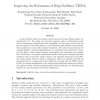Free Online Productivity Tools
i2Speak
i2Symbol
i2OCR
iTex2Img
iWeb2Print
iWeb2Shot
i2Type
iPdf2Split
iPdf2Merge
i2Bopomofo
i2Arabic
i2Style
i2Image
i2PDF
iLatex2Rtf
Sci2ools
190
Voted
TRETS
2010
2010
Improving the Robustness of Ring Oscillator TRNGs
A ring oscillator based true-random number generator design (Rings design) was introduced in [1]. The design was rigorously analyzed under a mathematical model and its performance characteristics were established. In this paper we focus on the practical aspects of the Rings design on a reconfigurable logic platform and determine their implications on the earlier analysis framework. We make recommendations for avoiding pitfalls in real-life implementations by considering ring interaction, transistor level effects, narrow signal rejection, transmission line attenuation, and sampler bias. Furthermore, we present experimental results showing that changing operating conditions such as the power supply voltage or the operating temperature may affect the output quality when the signal is subsampled. Hence, an attacker may shift the operating point via a simple non-invasive influence and easily bias the TRNG output. Finally, we propose modifications to the design which significantly improves ...
| Added | 22 May 2011 |
| Updated | 22 May 2011 |
| Type | Journal |
| Year | 2010 |
| Where | TRETS |
| Authors | Sang-Kyung Yoo, Deniz Karakoyunlu, Berk Birand, Berk Sunar |
Comments (0)

